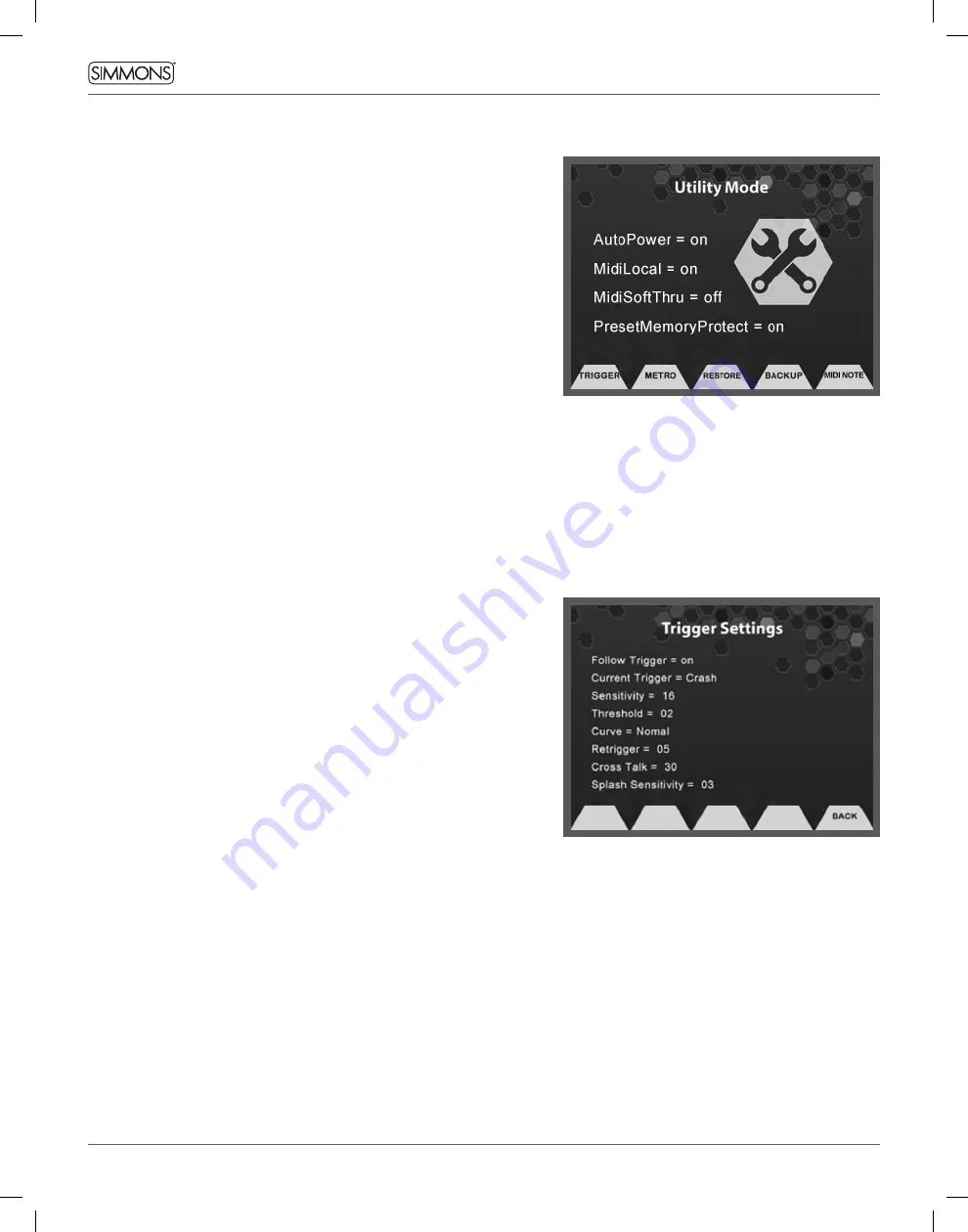
22
OWNER’S MANUAL
UTILITY MODE
The Utility mode contains the settings for the module operations that
aren’t in the Kit or Song modes.
The main screen settings are:
• Auto Power- on/off: Turns off module after 4 hours of no use.
• MIDI Local- on/off: Local on/off helps to fix MIDI loop issues. Set to
off if you are recording to an external MIDI sequencer.
• MIDI Soft Thru- on/off: Turns the MIDI out into a MIDI Thru to
daisy-chain several MIDI devices.
• Preset Memory Protect on/off: This protects the preset Kits from
Modification. When set to OFF, you can save into the preset kit
locations.
TRIGGER
The Trigger settings are optimized for the best playability for the
SD1250. However some players will want different settings, add other
brands of pads, or may place the drums on the rack in a different
manner than the factory setup. In these cases, you may find it helpful
modify the trigger settings for your own playability. To Enter the
Trigger settings menu press the Function button under Trigger on the
Main Utility screen.
Note: When changing the trigger parameters on the various parts
of the kit, the trigger responses with the kit will be slow. This is
due to the module refreshing the information on the screen. We
recommend setting the trigger parameters one drum or cymbal at
a time and then verifying your settings by pressing the Function
Back button to return to the main Utility screen.
TRIGGER SETTINGS (GLOBAL):
• Follow Trigger - On/Off: This allows you to select the drum or
cymbal to edit by striking it.
• Current Trigger: This allows you to manually select the trigger input
for editing.
• Sensitivity: This adjusts the sensitivity of the pad trigger to regulate
the pad response. Higher settings result in higher sensitivity, so that
the pad will produce a loud volume even when struck softly. The
range is 1 to 32.
• Threshold: This setting allows a trigger signal to be received only
when the pad is struck harder than a specified force. This can be
used to prevent a pad from sounding in response to extraneous
vibrations from another pad. The range is 0-50.
• Curve: These curves can be set per pad. Depending on your playing
style you may want to use different curves for different drums and
cymbals. There are four choices:
Easy:
Good for players that want to reach high dynamic response
without hitting too hard.
Fixed:
The sound will be at a fixed volume each time, regardless of
how hard a pad is hit.
Normal:
The most linear playing curve.
Dynamic:
Offers the highest dynamic range.
• Retrigger -1-8: The trigger response of the SD1250 has been
designed to exactly match the signals produced by the SD1250
drum and cymbal pads. Triggering the SD1250 from other
commercially available pads or triggers may result in ‘double
triggering’ due to the long decay characteristics of some types of
pickups. Setting the retrigger value to a lower number can in most
cases eliminate unwanted double triggering, although this may
prevent intentional rapid playing such as a drum roll or flam. If you
experience an unwanted double trigger, try reducing the default
value (6 for most drums). The value 1 will prevent rapid triggers
of 500ms or so, where the value 8 will let all triggers through no
matter how close together they are.
• Crosstalk - 0-75: When two pads are mounted on
the same stand, the vibration produced by hitting
one pad may trigger the sound from another pad
unintentionally (This is called crosstalk.) You can
avoid this problem by adjusting Crosstalk Cancel on
the pad that is sounding inadvertently. If the value
is set too high, then when two pads are played
simultaneously, the one that is struck less forcefully
will not sound. So be careful and set this parameter
to the minimum value required to prevent such
crosstalk. With a setting of 0 crosstalk prevention
does not function.
• Splash Sensitivity - 1-8: This adjusts the hi hat pedal
splash sensitivity.






























